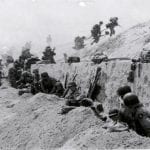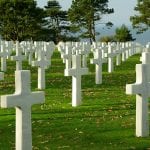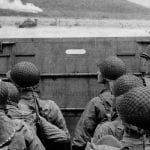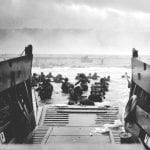The following article on the 79th Armoured Division is an excerpt from Barrett Tillman’ D-Day Encyclopedia. It is available for order now from Amazon and Barnes & Noble.
Maj. Gen. Sir Percy C. S. Hobart commanded the 79th Armoured Division, the primary British tank force in Normandy. His division was composed of the First Tank Brigade, Thirtieth Armoured Brigade, and First Assault Brigade, composed of Royal Engineer units. The First Canadian Armoured Personnel Carrier Regiment was attached.
Independent brigades of Thirty-first Army Group included Fourth Armoured, Sixth Guards Tank, Eighth Armoured, Thirty-first Tank, Thirtythird Armoured, Thirty-fourth Tank, Fifty-sixth Infantry Brigade, First and Second Special Service Brigade, and Second Canadian Armoured.
First Special Service (Commando) Brigade
Commanded by the charismatic Brigadier Simon Fraser, Lord Lovat, the First Special Service Brigade was formed specifically for the Normandy landings. Its components were Nos. 3, 4, and 6 Commandos of the British army, No. 45 Royal Marine Commando, and part of No. 10 Interallied Commando, mainly comprised of Free French troops. The brigade’s total strength amounted to some 2,500 men.
Landing on Sword Beach, Lovat’s forces advanced through lines held by the Third Division’s Eighth Brigade. The commandos’ main objective was relief of the British Sixth Airborne Division, which had seized vital bridges over the Orne River.
On 7 June Lovat’s marines attacked east of the Orne Estuary, while No. 3 Commando assaulted the Merville Battery of coastal defense guns. Both efforts were repulsed, but the brigade ceded little ground to determined counterattacks. Repeated thrusts were made by German armor, including the Twenty-First Panzer Division. The commandos seized Breville on D+6, and though Lovat was badly wounded, the eastern flank of the landing beaches had been secured.
The brigade was withdrawn after ten weeks in combat, sustaining nearly a thousand casualties.
This article on the 79th Armoured Division is part of our larger selection of posts about the Normandy Invasion. To learn more, click here for our comprehensive guide to D-Day.
 |
 |
 |
This article is from the book D-Day Encyclopedia, © 2014 by Barrett Tillman. Please use this data for any reference citations. To order this book, please visit its online sales page at Amazon or Barnes & Noble.
You can also buy the book by clicking on the buttons to the left.
Cite This Article
"79th Armoured Division: Britain’s Normandy Tank Force" History on the Net© 2000-2024, Salem Media.
July 27, 2024 <https://www.historyonthenet.com/79th-armoured-division>
More Citation Information.










